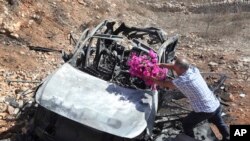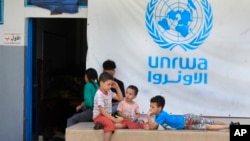UNICEF warns the conflict in Gaza and mounting violence between Israel and Hezbollah are increasing the suffering of tens of thousands of children in Lebanon caught in the crosshairs of this escalating regional crisis.
A report issued by the United Nations Children’s Fund this week calls for an immediate, permanent cease-fire in Gaza as an essential prerequisite for protecting the lives and well-being of children and civilians in Lebanon and beyond.
“Without that, Lebanon is at risk of a full-scale war which would have a devastating impact on the 1.3 million children living in the country, as well as the rest of the children in the region,” said UNICEF spokesperson James Elder.
Presenting the report at a Geneva press conference, Elder said humanitarian needs were surging across Lebanon as airstrikes by Israel Defense Forces have progressively increased and “hit deeper into a country already suffering protracted economic and political crises.”
Israel has been exchanging frequent fire with Lebanon’s Hezbollah militants.
“UNICEF has previously warned of Lebanon’s unrelenting, overlapping emergencies and their impact on children and education. Today these are compounded by almost daily airstrikes,” he said.
According to Lebanon’s Ministry of Public Health, airstrikes have damaged civilian infrastructure and facilities, killing 344 people, including eight children and 21 women, since October 7, when Israel began its offensive in Gaza in response to a Hamas attack that killed some 1,200 people and saw 240 abductions.
“Together with those children killed and scores injured, 30,000 children have been displaced,” said Elder. “Infrastructure that children rely on is being destroyed, including significant damage to water stations, thus denying 100,000 people access to safe drinking water. Around 23 health care facilities, serving 4,000 people, are also closed due to the hostilities.
“Should the conflict continue to escalate, UNICEF warns that repercussions for children will be devastating,” he said.
Before the conflict, UNICEF reports, some 700,000 children in Lebanon were out of school. It says Lebanon’s pre-existing education crisis has since worsened, noting that the recent violence has forced the closure of 72 schools in southern Lebanon, disrupting the education of an additional 20,000 students.
The agency says nearly half of Lebanon’s 5.49 million population live below the poverty line, while an estimated 90% of its more than 1 million Syrian-refugee households live in extreme poverty.
“There are some commonalities between Syrian and Lebanese children, and Palestinian children on the ground in that the vast majority of children in Lebanon are not having their needs met,” Ettie Higgins, deputy head of office for UNICEF in Lebanon, told journalists Tuesday.
She observed that tensions between communities and nationalities have risen due to the lack of resources brought on by “a massive collapse of humanitarian funding in Lebanon in the past few months.”
“This has forced us to cut back virtually on all of our services, including the provision of safe drinking water and simple things like getting rid of sewage in communities.”
She acknowledged that cutbacks in food and other essential life-saving commodities and services are having a profound impact on the health and well-being of children.
This is borne out by data collected for a comprehensive nutrition assessment conducted by UNICEF in Lebanon last year. Higgins said the results, which will be released next month, “point to a very, very worrying situation, particularly for children who are living in informal settlements.”
“The rates of stunting and wasting [becoming underweight for height] are much higher than we, unfortunately, had assumed,” she said, noting that there has been “a three-fold increase in children being referred to malnutrition programs in the past 12 months.”
Discussing Lebanon’s economic meltdown, she said: “Now in the fourth year of this massive catastrophe that has hit Lebanon, we are seeing tensions spike, and this is having an impact on children daily.”
Higgins added that Palestinian refugees who have been living for a long time in terrible conditions in camps and settlements are experiencing “the secondary trauma of seeing what is happening to fellow Palestinians in Gaza and the West Bank.”
She said destitute families who are unable to make ends meet have been forced into negative and sometimes potentially dangerous coping mechanisms to survive.
“We are seeing families sending the entire family out to beg. They are forcing children as young as four to work in agriculture. And this means that their overall health and well-being are impacted,” she said.
“I spoke to a doctor recently who said that he had 7-year-olds coming to him with back problems because of the heavy loads of trash that they are carrying on a daily basis,” she added. “And this was to earn maybe two dollars a day, just to be able to eat and put a meal on the table."











